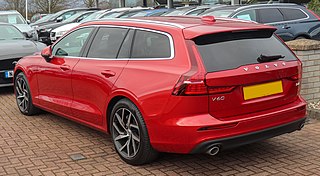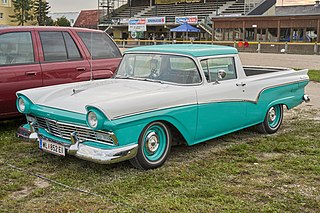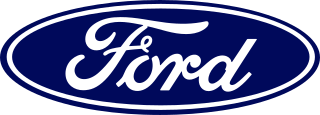Related Research Articles

Jeep is an American automobile marque, now owned by multi-national corporation Stellantis. Jeep has been part of Chrysler since 1987, when Chrysler acquired the Jeep brand, along with remaining assets, from its previous owner American Motors Corporation (AMC).

Minivan is a car classification for vehicles designed to transport passengers in the rear seating row(s), with reconfigurable seats in two or three rows. The equivalent classification in Europe is MPV . In Southeast Asia, the equivalent classification is Asian Utility Vehicle (AUV).
Dodge is an American brand of automobiles and a division of Stellantis North America, based in Auburn Hills, Michigan. Dodge vehicles have historically included performance cars, and for much of its existence Dodge was Chrysler's mid-priced brand above Plymouth.

A sport utility vehicle (SUV) is a car classification that combines elements of road-going passenger cars with features from off-road vehicles, such as raised ground clearance and four-wheel drive.

A van is a type of road vehicle used for transporting goods or people. Depending on the type of van, it can be bigger or smaller than a pickup truck and SUV, and bigger than a common car. There is some variation in the scope of the word across the different English-speaking countries. The smallest vans, microvans, are used for transporting either goods or people in tiny quantities. Mini MPVs, compact MPVs, and MPVs are all small vans usually used for transporting people in small quantities. Larger vans with passenger seats are used for institutional purposes, such as transporting students. Larger vans with only front seats are often used for business purposes, to carry goods and equipment. Specially equipped vans are used by television stations as mobile studios. Postal services and courier companies use large step vans to deliver packages.

A station wagon or estate car, is an automotive body-style variant of a sedan/saloon with its roof extended rearward over a shared passenger/cargo volume with access at the back via a third or fifth door, instead of a trunk/boot lid. The body style transforms a standard three-box design into a two-box design—to include an A, B, and C-pillar, as well as a D-pillar. Station wagons can flexibly reconfigure their interior volume via fold-down rear seats to prioritize either passenger or cargo volume.

The Ford Sierra is a mid-size car or large family car manufactured and marketed by Ford Europe from 1982–1993, designed by Uwe Bahnsen, Robert Lutz and Patrick le Quément — and noted for its aerodynamic styling producing a drag coefficient of 0.34, a significant improvement over its predecessors.

The Ford Ranchero is a coupe utility that was produced by Ford between 1957 and 1979. Unlike a standard pickup truck, the Ranchero was adapted from a two-door station wagon platform that integrated the cab and cargo bed into the body. A total of 508,355 units were produced during the model's production run. Over its lifespan it was variously derived from full-sized, compact, and intermediate automobiles sold by Ford for the North American market.

The Ford Falcon is a full-sized car that was manufactured by Ford Australia from 1960 to 2016. From the XA series of 1972 onward, each Falcon and range of derivates have been designed, developed, and built in Australia, following the phasing out of the American-influenced Falcon of 1960 to 1971, which had been re-engineered locally as the XK to XY series for the harsher Australian conditions. The luxury-oriented Ford Fairmont model joined the range from 1965. Luxury long-wheelbase derivative versions called the Ford Fairlane and LTD arrived in 1967 and 1973 respectively with production ending in 2007.
Governments and private organizations have developed car classification schemes that are used for various purposes including regulation, description, and categorization of cars.
Dinky Toys was the brand name for a range of die-cast zamak zinc alloy scale model vehicles, traffic lights, and road signs produced by British toy company Meccano Ltd. They were made in England from 1934 to 1979, at a factory in Binns Road in Liverpool.

Ford Motor Company of Australia Limited is the Australian subsidiary of United States-based automaker Ford Motor Company. It was founded in Geelong, Victoria, in 1925 as an outpost of Ford Motor Company of Canada, Limited. At that time, Ford Canada was a separate company from Ford USA. Henry Ford had granted the manufacturing rights of Ford motor vehicles in the British Empire, to Canadian investors.

A panel van, also known as a blind van, car-derived van or sedan delivery, is a small cargo vehicle with a passenger car chassis, typically with a single front bench seat and no side windows behind the B-pillar. Panel vans are smaller than panel trucks or cargo vans, both of which use body-on-frame truck chassis.

The Willys MB and the Ford GPW, formally the U.S. Army Truck, 1⁄4-ton, 4×4, Command Reconnaissance, informally the Willys Jeep, Jeep, or jeep, and sometimes referred to by its supply catalogue designation G503, are American off-road four-wheel drive military light utility vehicles, built in large numbers to a single standardized design, for the United States and the Allies of World War II from 1941 until 1945.

The Ford Falcon is a model line of cars that was produced by Ford from the 1960 to 1970 model years. Though preceded by the Rambler American, the Falcon was the first compact car marketed by the Big Three American manufacturers.

The Holden was a full-sized car produced by the company of the same name across 5 generations from 1948 until 1984. The Holden is also commonly referred to by their model designation and also the H Series. The Holden was introduced to be Australia's car, being the first full scale produced automobile exclusive to the country. Prior to which, General Motors Holden's Ltd. assembled imported CKD kits from overseas General Motors subsidiaries such as Chevrolet, Buick, Vauxhall and more. And the only other cars built in the country being Ford and Chrysler vehicle bodies fitted to imported chassis. The Holden was an instant success among Australians, being the first production car built solely for Australia's unique, rough roads.

The Land Rover series I, II, and III, or simply the Land-Rover are compact British off-road vehicles, produced by the Rover Company since 1948, and later by British Leyland. Though inspired by the World War II jeep, the Land Rover immediately distinguished itself from all other cars. From launch, it was the first mass-produced civilian four-wheel drive car with doors on it, and an available hard roof. Contrary to conventional car and truck chassis, it used a sturdier fully box-welded frame. Furthermore, due to post-war steel shortage, and aluminium surplus, Land Rovers received non-rusting aluminium alloy bodies, favouring their longevity. In 1992, Land Rover claimed that 70% of all the vehicles they had built were still in use.

Canadian Military Pattern (CMP) trucks were mutually coherent ranges of military trucks, made in large numbers, in several classes and numerous versions, by Canada's branches of the U.S. 'Big Three' auto-makers during World War II, compliant to British Army specifications, primarily intended for use in the armies of the British Commonwealth allies, but also serving in other units of the British Empire.

The Dodge Town Panel and Dodge Town Wagon are respectively a panel truck and a carryall, manufactured between 1954 and 1966 in the US and between 1954 and 1971 in Argentina by Dodge. The Town Panel and Town Wagon trucks were based upon the design of the Dodge C Series pickup trucks with round fenders and wraparound windshields. Even after the Dodge D Series "Sweptline" pickup trucks with square fenders and flat windshields were released, the Town Wagons retained the 1958 sheet metal design of the C Series pickups and heavy-duty trucks. They were produced until 1966, when the Dodge A100 Commercial and passenger vans eliminated the need for the pickup chassis version. A passenger sport utility version of the Dodge D series truck was not again developed until the third generation D Series based Dodge Ramcharger, a competitor to the Chevrolet Blazer.

The Bedford HC is a small commercial vehicle that was made by Bedford, beginning in 1938. The vehicle shared its running gear with the H-series Vauxhall 10-4 saloon. Production of civilian vehicles ceased during World War II with the HC van re-entering production for a little while following hostilities. The HC was later joined by the heavier duty Bedford JC, which was itself replaced by the higher-roofed Bedford PC after the war. With the arrival of the much more modern Bedford CA the by now outmoded PC was finally retired.
References
- ↑ Vanderveen, Bart (1989). Historic Military Vehicles Directory. ISBN 0900913576.